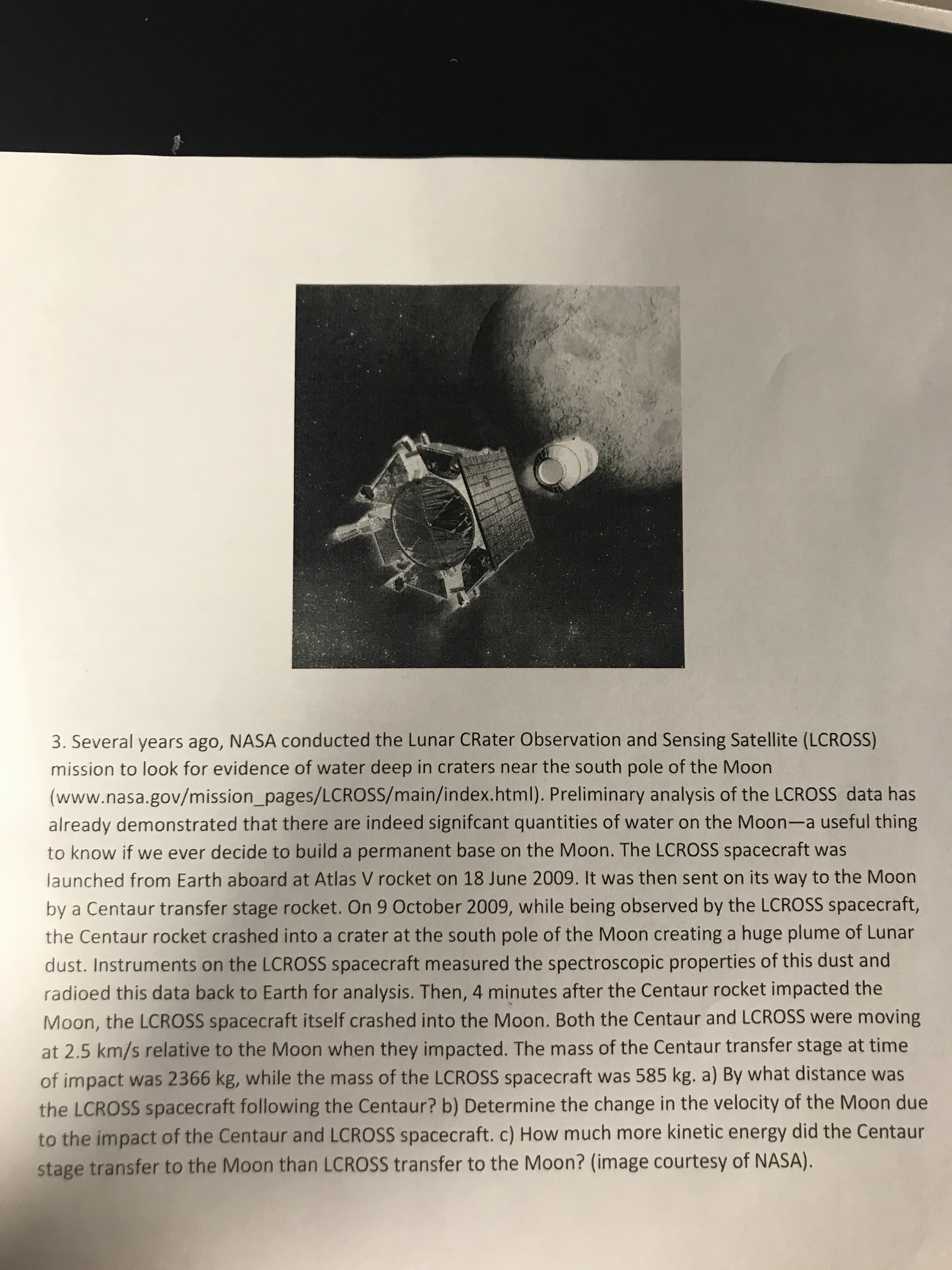3. Several years ago, NASA conducted the Lunar CRater Observation and Sensing Satellite (LCROSS) mission to look for evidence of water deep in craters near the south pole of the Moon (www.nasa.gov/mission_pages/LCROSS/main/index.html). Preliminary analysis of the LCROSS data has already demonstrated that there are indeed signifcant quantities of water on the Moon-a useful thing to know if we ever decide to build a permanent base on the Moon. The LCROSS spacecraft was launched from Earth aboard at Atlas V rocket on 18 June 2009. It was then sent on its way to the Moon by a Centaur transfer stage rocket. On 9 October 2009, while being observed by the LCROSS spacecraft, the Centaur rocket crashed into a crater at the south pole of the Moon creating a huge plume of Lunar dust. Instruments on the LCROSS spacecraft measured the spectroscopic properties of this dust and radioed this data back to Earth for analysis. Then, 4 minutes after the Centaur rocket impacted the Moon, the LCROSS spacecraft itself crashed into the Moon. Both the Centaur and LCROSS were moving at 2.5 km/s relative to the Moon when they impacted. The mass of the Centaur transfer stage at time of impact was 2366 kg, while the mass of the LCROSS spacecraft was 585 kg. a) By what distance was the LCROSS spacecraft following the Centaur? b) Determine the change in the velocity of the Moon due to the impact of the Centaur and LCROSS spacecraft. c) How much more kinetic energy did the Centaur stage transfer to the Moon than LCROSS transfer to the Moon? (image courtesy of NASA).
3. Several years ago, NASA conducted the Lunar CRater Observation and Sensing Satellite (LCROSS) mission to look for evidence of water deep in craters near the south pole of the Moon (www.nasa.gov/mission_pages/LCROSS/main/index.html). Preliminary analysis of the LCROSS data has already demonstrated that there are indeed signifcant quantities of water on the Moon-a useful thing to know if we ever decide to build a permanent base on the Moon. The LCROSS spacecraft was launched from Earth aboard at Atlas V rocket on 18 June 2009. It was then sent on its way to the Moon by a Centaur transfer stage rocket. On 9 October 2009, while being observed by the LCROSS spacecraft, the Centaur rocket crashed into a crater at the south pole of the Moon creating a huge plume of Lunar dust. Instruments on the LCROSS spacecraft measured the spectroscopic properties of this dust and radioed this data back to Earth for analysis. Then, 4 minutes after the Centaur rocket impacted the Moon, the LCROSS spacecraft itself crashed into the Moon. Both the Centaur and LCROSS were moving at 2.5 km/s relative to the Moon when they impacted. The mass of the Centaur transfer stage at time of impact was 2366 kg, while the mass of the LCROSS spacecraft was 585 kg. a) By what distance was the LCROSS spacecraft following the Centaur? b) Determine the change in the velocity of the Moon due to the impact of the Centaur and LCROSS spacecraft. c) How much more kinetic energy did the Centaur stage transfer to the Moon than LCROSS transfer to the Moon? (image courtesy of NASA).
Chapter4: Physics Of Matter
Section: Chapter Questions
Problem 30Q
Related questions
Question

Transcribed Image Text:3. Several years ago, NASA conducted the Lunar CRater Observation and Sensing Satellite (LCROSS)
mission to look for evidence of water deep in craters near the south pole of the Moon
(www.nasa.gov/mission_pages/LCROSS/main/index.html). Preliminary analysis of the LCROSS data has
already demonstrated that there are indeed signifcant quantities of water on the Moon-a useful thing
to know if we ever decide to build a permanent base on the Moon. The LCROSS spacecraft was
launched from Earth aboard at Atlas V rocket on 18 June 2009. It was then sent on its way to the Moon
by a Centaur transfer stage rocket. On 9 October 2009, while being observed by the LCROSS spacecraft,
the Centaur rocket crashed into a crater at the south pole of the Moon creating a huge plume of Lunar
dust. Instruments on the LCROSS spacecraft measured the spectroscopic properties of this dust and
radioed this data back to Earth for analysis. Then, 4 minutes after the Centaur rocket impacted the
Moon, the LCROSS spacecraft itself crashed into the Moon. Both the Centaur and LCROSS were moving
at 2.5 km/s relative to the Moon when they impacted. The mass of the Centaur transfer stage at time
of impact was 2366 kg, while the mass of the LCROSS spacecraft was 585 kg. a) By what distance was
the LCROSS spacecraft following the Centaur? b) Determine the change in the velocity of the Moon due
to the impact of the Centaur and LCROSS spacecraft. c) How much more kinetic energy did the Centaur
stage transfer to the Moon than LCROSS transfer to the Moon? (image courtesy of NASA).
Expert Solution
This question has been solved!
Explore an expertly crafted, step-by-step solution for a thorough understanding of key concepts.
This is a popular solution!
Trending now
This is a popular solution!
Step by step
Solved in 3 steps with 6 images

Recommended textbooks for you


Astronomy
Physics
ISBN:
9781938168284
Author:
Andrew Fraknoi; David Morrison; Sidney C. Wolff
Publisher:
OpenStax

Horizons: Exploring the Universe (MindTap Course …
Physics
ISBN:
9781305960961
Author:
Michael A. Seeds, Dana Backman
Publisher:
Cengage Learning


Astronomy
Physics
ISBN:
9781938168284
Author:
Andrew Fraknoi; David Morrison; Sidney C. Wolff
Publisher:
OpenStax

Horizons: Exploring the Universe (MindTap Course …
Physics
ISBN:
9781305960961
Author:
Michael A. Seeds, Dana Backman
Publisher:
Cengage Learning

An Introduction to Physical Science
Physics
ISBN:
9781305079137
Author:
James Shipman, Jerry D. Wilson, Charles A. Higgins, Omar Torres
Publisher:
Cengage Learning